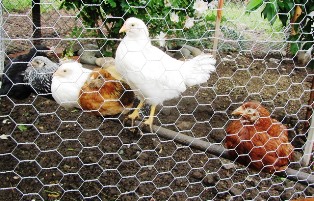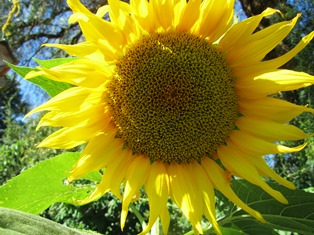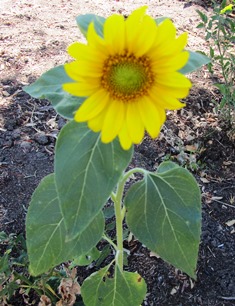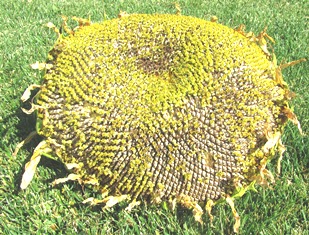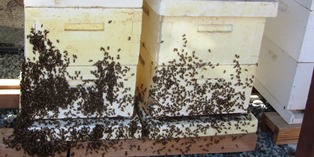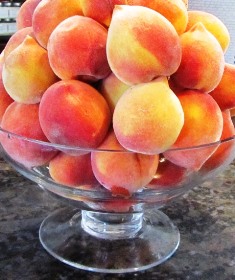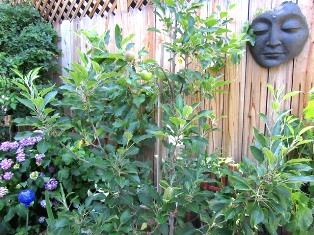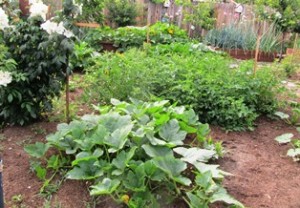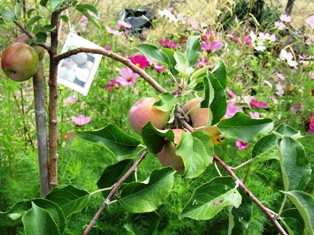Archive for the 'Health and Well-Being' Category
If It’s Good Enough for Bill Gates, I Might Try It, Too
On Sunday mornings on our farmette, we almost always have potatoes, assorted cheeses and fresh fruit, along with homemade bread, honey, and a jar of apricot or strawberry jam that I’ve put up during jam season. But organic eggs from my free-range heritage chickens takes center stage, scrambled or poached (my favorite, a la Jacques Pépin and Julia Child), or cooked in an omelet with fresh herbs.
People who can’t eat poached, scrambled, or omelet eggs because of cholesterol concerns or egg allergies often make do without eggs or indulge their omelet craving with egg substitutes. But what about egg-free cookie dough or mayonnaise?
Enter Eco-food innovator, Hampton Creek Foods. The company’s biochemical scientists at work at the three-year-old, San Francisco-based company have come up with an egg substitute that is plant-based. It has already found a perfect plant-based recipe for egg-free mayonnaise and cookie dough.
With its egg substitute, Beyond Eggs, and other products, the company seeks to crack open an industry that produces 1.1 trillion eggs annually.
According to Katie Fehrenbacher, writing last year for Gigaom, Hampton Creek Foods CEO Josh Tetrik says “the food industry is broken.” See, http://gigaom.com/2013/09/11/hampton-creek-now-selling-plant-based-eggs-at-whole-foods-in-california/
Hampton Creek touts its plant-based, egg-free formulas as cheaper, healthier, and more humane. With its emphasis on food technology, Hampton Creek has attracted interest and funding from Silicon Valley venture capitalists and the world’s super-wealthy billionaire Bill Gates and Li Ka-shing, Asia’s richest man.
Earlier this year, Forbes writer Ryan Mac discussed Hampton Creek’s food technology venture that has attracted the interest of Yahoo co-founder Jerry Wang and Li Ka-shing. See, http://www.forbes.com/sites/ryanmac/2014/02/17/egg-replacing-startup-hampton-creek-foods-raises-23-million-from-asias-richest-man-and-yahoo-cofounder-jerry-yang/
In California, foodies can find Hampton Creek’s Beyond Eggs at Whole Foods stores. Those who love the real thing can buy eggs labeled as organic, produced by pastured free-range flocks.
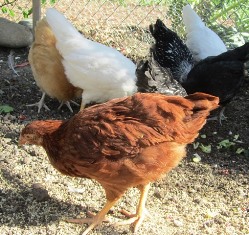
A Rhode Island Red forages with a Buff Orpington, two White Leghorns, a Black Sex Link, and two Silver-laced Wyandottes
According to tests conducted by Mother Earth News,the eggs from free-range pastured chickens have more beta carotine, vitamin A, vitamin E, and Omega-3 fatty acids with less cholesterol and less saturated fat than most store-bought eggs from chickens that weren’t pastured. See, http://www.motherearthnews.com/real-food/free-range-eggs-zmaz07onzgoe.aspx#axzz3CB01GPlj
Sunday mornings on the farmette wouldn’t be the same without fresh eggs from the hen house, but if Bill Gates likes Hampton Creek Foods’ products, I might just give them a try. Still, I’m having a hard time imagining how the taste of an egg substitute from a yellow-pea and canola concoction could rival an organic egg.
Travel Is a Gift that Keeps on Giving
Farmette life keeps me close to home these days, but lately I’ve been thinking about some of the places I’ve been in the world and it occurred to me that travel has inspired and, in many ways, transformed me. It also has broadened my horizons, shaped my worldview, and contributed immeasurably to my sense of well-being.

Ephesus, a few miles from Kusadasi, on Turkey’s turquoise coast, has spectacular ruins like this Greco-Roman library
The nice thing about travel is that it also can nurture your spirit and inform your writing. Since I’ve traveled a bit–something like 29 countries–mostly for pleasure and always on my own dime, I’ve met some wonderful people, tasted some great cuisine and wines, saw fantastic architecture, and learned colorful, cultural tidbits along the way.
Today as I was working on my Henny Penny Farmette mystery series, I thought about how I’d tasted the organic wines and fresh herbs of Greece, the chocolates of Belgium, honey in England, jams and tea in Ireland and Wales, spices of all kinds in India, wine and cheese in France, shortbread and butter cookies in Scotland, apple strudel all over Switzerland and Austria, and fine olive oil in Italy.
Travel for me is about food, people, and experiences during the journey. So often, in our world of bucket lists and destination travel, we miss the point of the journey. For me, it’s the life on the road that happens on the way to a destination that informs my writing and my worldview.
My first cozy mystery BEELINE TO MURDER draws upon farmette life and deals with beekeeping and honey and pastries, but also ties into the Caribbean. That book will be released October 2015.
My second book in the cozy mystery series focuses on herbs and has a tie-in to Haiti. That book comes out October 2016.
The third book involves the world of artisan chocolate. That book will be released October 2017. To write these books, I draw deeply from the well of experience and tap into my senses. Although the main focus of my novels is about solving a murder mystery, the stories always involve food and drink–a universal experience involving the senses.
For millennia, people have lived close to the earth, growing their own food, pressing their olives into oil, harvesting honey from their hives, and making their own wine. It’s how many of us choose to live today. That sense of connectedness–resonating across cultures, through centuries–informs my writing most of all.
Gunshot Triggers Howls and Cackles in the Hood
Farm life isn’t always quiet. Night before last, a shot rang out around 11:00 p.m. It happened after some people in the neighborhood had engaged in a running argument, lasting hours.
My husband and I heard the arguing during our romantic dinner on the patio. His birthday is tomorrow and we celebrate birthdays all week, you see.
Hubby said he knew the sound of gunshots when he heard them. He was even more certain he’d heard the words, “We got to get out of here!” I was tempted to dive under the bed because people on the run with guns . . . well, that could be dangerous.
In the dark, you don’t know what has happened. I write mysteries. I’m thinking, “is there a body on the adjacent property?”
Three uniformed police officers arrive with nightsticks in their duty belts and guns in their holsters. With their flashlights drawn and turned on, they searched for a way into fortress that the neighbor has built or a means to see behind the tarps the neighbor has strung to hide his backyard and sheds.
Over the barking of the neighbor’s pit bull, I heard one officer tell the others, “This is like the Beverly Hillbillies. We’re notifying Code Enforcement.”
Glad it wasn’t our place they were talking about. We’ve been renovating . . . but neatly. Still, there’s the unfinished porch, the pile of lumber . . . .
I watched the erratic beams of their flashlights as they searched. Then . . . here they come, lights bobbing, down our driveway. They want to see if they can penetrate the fortress of the Beverly Hillbillies from another direction. Our house is in close proximity.
My husband went searching for a ladder. Call me silly, but I thought it would be the tall, thin officer, who would climb up. No, that would be too logical. It was the short, chunky one scaling into the heights, disappearing into the elm tree. Did I mention the tree has an almost impenetrable canopy in summer? Not surprising that he couldn’t see anything.
The officers decided on a look-see from the rear. My hubby guided them through a field, past the apiary and chicken house.
Roosting chickens are usually quiet. No doubt, you’ve heard the expression, “Going to bed with the chickens, rising with the rooster.” To say my hens were alarmed might be an understatement. They’d been roused from their slumber and cackled like there was no tomorrow. I realize there’s a bit of irony in the fact that our place is called the Henny Penny Farmette after Chicken Little’s story about the acorn falling on her head. This could have been the sky falling. They cackled like it was.
The deafening cackles agitated the neighbor’s pit bull, whose incessant barking got all the dogs in the hood howling. A fire engine shot by, sirens blaring. I took an aspirin, waited for my husband to return and the officers to leave.
Back in bed, who could sleep? I worried about when about when Code Enforcement might show up to cite the Beverly Hillbillies. Would the officers look over the fence and cite us as well? Code Enforcement aside, a gun-toter could hide behind our pile of porch lumber. We gotta get that porch finished.
But, like I said, it’s my husband’s birthday. He’s feeling romantic this week and not easily pushed. See my conundrum?
Sunflowers-A Source of Beauty and Food
Sunflowers have inspired human expression for centuries. The Incas made the sunflower a symbol of their god. In Europe, sunflowers symbolized kingship and were cultivated in gardens, at least until the 18th Century when they fell out of favor. The artist Vincent Van Gogh immortalized these sun-facing flowers in his paintings that bear witness to the hot summers he spent in Arles.
In fact, nothing symbolizes summer like the sunny faces of sunflowers. That image of beauty is a widely used motif in garden art and home goods. Freshly cut sunflowers in a jar, vase, or tin can brighten any room in which they are placed.
Native Americans ate the seeds or ground them for use in breads and cakes and used the dyes for body paint and clothing. Today the seeds are dried and roasted or sold as natural. The oil is pressed and used in cooking. Sunflower seeds are high in protein and are considered a healthy snack.
Even children can plant and tend sunflowers; they are easy to grow. The giant cultivars require ample garden space but planted in a circle or square, they can become a living fort that children enjoy playing under. Sunflowers are heavy feeders, so amending the soil with compost and manure will benefit their growth cycle. The plants are not particular about soil type but they do need regular watering.
Sunflowers can bear a single head, containing petals and seeds, or several heads on a single stalk. They range in size from small to giant stalks of twenty feet or more. Giant heads grow as much as two feet across.
Depending on the cultivar, the centers of these lovely flowers range from dark brown or black, or gray and white striped. The seeds are a favorite food of squirrels and birds and honeybees. Here on our farmette, we grow sunflowers near the apiary along with lavender. High-value food sources keep the bees around to pollinate the rest of our garden. And I can’t resist putting a few small heads in a jar to brighten my kitchen window.
Puzzling through a Cozy, Weeping at a Memoir, and Forgetting the Peach Pie
I couldn’t breathe in yesterday’s heat. But with so much work to be done around the farmette, I soldiered on, staking heirloom blue tomatoes. I hadn’t finished canning my organic apricots and now the plums and peaches were ready. I felt overwhelmed and longing for cool spot to sip tea, rest, and read.
We had already removed the apricots from our “torture tree” since we’ve been unable to surmount its many problems after planting it five years ago. Carlos wasted little time chain-sawing it down. I deadheaded the roses, while he dug out the stump.
Then with a clear view to our hives, we quickly realized that the we needed to suit up and install extenders or the bees would swarm. Even as we felt the urgency, we realized there were also dozens of other chores screaming for our attention.
I told myself that breezes would soon blow inland from the Carquinez Strait, a channel of the San Francisco Bay where the San Joaquin and the Sacramento Rivers flow to the ocean, but by mid-afternoon, nary a leaf moved on the apricot, plum, and pomegranate trees. By four o’clock when the wind finally did kick in–the air wasn’t cool as it usually was. The winds blew strong and stifling hot and threatened to suffocate anyone still working outside.
Abandoning the outside chores, I retreated indoors and turned on the air conditioner. Seeing the lug of apricots and crock of peaches resting on the kitchen counter, I groaned. The jam had to be made, but I couldn’t face stirring boiling fruit on a hot stove.
Deciding to use up some of the fruit for a simple after-dinner dessert, I flipped through the pages of a few cookbooks. Maybe a cobbler would do or a peach pie. I really didn’t need a recipe for those, but in Country Cooking by Dori Sanders, I found an intriguing raisin-cinnamon crust that sounded tasty. I bet it would go with peaches but I probably could have baked it on the patio floor.
With a glass of sweet tea and an armload of paperbacks and hardcovers, I curled up on the couch and finished reading Murder is Binding, Lorna Barrett’s debut book in her cozy Booktown Mystery series. I love this author and her writing, but soon figured out who done it. Still, I read to the end; you never know when a clever twist might show up.
Next, I read the last few pages of A Tuscan Childhood by Kinta Beevor. At bedtime, I’d been savoring the chapters of that book like pieces of rich, dark chocolate. Beevor’s evocative descriptions of her bohemian childhood in Tuscany captured my imagination, drawing me in so completely I could almost smell the wild thyme, pine needles, and rocky Tuscan terrain in the searing, summer heat. Like Frances Mayes (Under the Tuscan Sun), who wrote a quote for the cover, I felt sad when Beevor’s lovely memoir ended.
Returning to the stack, I selected another memoir, The Orchard, by Theresa Weir. I’d bought the book on impulse during a trip to the farmers’ market at Todos Santos Plaza, our downtown green space surrounded by bars and banks and, of course, a second-hand bookstore. Drastically marked down, the book had been summarily deposited on a set of moveable shelves, and rolled outside the storefront for a quick sale.
The artist and writer in me understood immediately why I had picked it up and purchased it: the cover art pictured a young couple in a loving embrace, standing in lush green grass surrounded by apple trees. But there was something in that image that evoked sadness, like a bittersweet dream of a time past, viewed through a long lens.
As the descendant of five generations of farmers, I suspected Weir’s book would resonate with my own experiences of farm life in America’s heartland with bone-chilling winters of snow and ice and sweltering summers when you prayed for rain. What I didn’t expect was exquisite writing and the juxtaposition of love against the deadly realities of widespread pesticide use on the farms that ushered me into her story and swept me along. I finished that book in one sitting and will long be haunted by it.
I felt guilty for having only paid pennies for Weir’s book. A pittance for a tale that evolved out of all she had lived through. Less than the price of bus fare to journey with her as she pieced together scenes from her life in the Heartland. In every page, I was with her as she struggled, never abandoning her dreams. She learned as I had how to tuck them away while you dealt with the realities of a hard life with heart-breaking lows and highs that reached euphoria. But there were scenes she left out, only hinting at experiences she said she would “never talk about.” The truth is, I wept after putting down her book.
When a reader identifies so closely with a character in a story (and this was Weir’s personal narrative of her life), he or she rides the emotional ups and downs with that character. Good writers understand how to tug at their readers’ emotions and milk the drama. Theresa Weir had skillfully threaded a leitmotif of darkness and light, joy and sorrow, pain and healing through her story, but never once did I feel manipulated. Every sentence of The Orchard rang true.
I couldn’t read anymore after putting that book down. As I made dinner, I thought of how many scenes in her life resonated with mine. Even the widespread pesticide use on farms and the stubbornness of farmers to change.
I thought about Rachel Carson’s famous book, Silent Spring, that sounded the wake-up call to farmers everywhere about the dangers of chemicals in fertilizers, pesticides, and herbicides. So many small farms have been overtaken by agribusinesses these days and still the chemicals are used. I decided to forgo making the peach pie.
With the heat of the day gone, I opened the windows and stretched out between freshly washed sheets. I listened to the rustle of oak and eucalyptus leaves. To crickets and the unseen critters that make noises in the night. I listened to the soft voices of my Lebanese neighbors chatting in their orchard with relatives.
As dreams beckoned, I could almost smell the fresh lilacs that Theresa Weir had written about in her memoir. Their cloying scent had filled her grandmother’s kitchen just as they had filled my grandmother’s, my mother’s, and mine. I wondered if the lilacs would ever disappear or if the world would one day wake up to find the honeybees gone, the fruit trees without fruit, and the berries and other sweet produce in our gardens and orchards reduced to a memory.
Building A Honeybee House
For my birthday this year, my husband surprised me with some practical beekeeping gifts and a promise to build an attractive bee house to hold our hives. In a plastic, five-gallon honey bucket, he’d placed a beekeeper’s suit, goatskin gloves, and a smoker.
This weekend, he made good on his promise. Although the temps hit 85 on Saturday and Sunday, he suited up in a lightweight beekeeper’s topper with protective netting over the face and got to work measuring, cutting, and securing the waterproofing material, hammering it in place.
With the waterproofing material attached to the roof and sides, he then covered the structure with old fence boards. But it wasn’t easy to mark the cut lines wearing gloves much less cutting the boards with the arm and table saws. He peeled the gloves off.
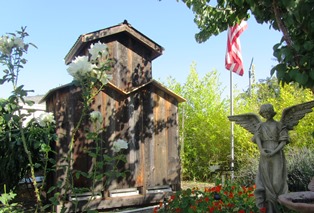
Beekeeper access is through the rear; the upper story holds a supply shelf; bee entrances are at the front bottom
Now, I know one thing about honeybees. Knocking at their door (say, with a hammer) will bring the guards out and they’ll sting . . . which they did.
My husband was on a mission and wasn’t about to let a bee sting stop him. He rubbed the spot with an ice cube, refused to take any Benadry®, and returned to work. But, not before donning some gloves.
But the gloves he put on weren’t beekeeping gloves. They were gardening gloves, good for deadheading roses but not much of a defense against venom-filled stingers.
So, for a little additional insurance against any more bee stings, we lit the smoker to calm the bees a bit. My husband was nearly finished working around the entrance to the hive when one of the honeybees apparently took notice of the fabric portion of the glove and stung right through it.
Even then, Carlos didn’t want to stop working. Only two metal roof sections remained to be cut, placed, and secured along with a shelf for the supplies. But it was sunset. The bees were going in for the night, and we were working in their flight path. We decided to call it a day, too.
The bee house roof will need to be finished before the rainy season starts in November. The good news is that the bees won’t bother Carlos if he stays in back of their house or on the roof. Activity at their front door sends an alarm through the entire colony that a predator is trying to get in. The honeybee defense is to go into attack mode, even if the “predator” in this case is the architect who designed and built their darling little house.
Ten Ways Cool Down on a Hot Day (and Safeguard Your Health)
On this second day of summer, the thermometer is telling me what I already know. It’s dang hot! I’m thinking hot enough for a sunstroke as I watch the apricots fall from the tree, the honeybees cling to the exterior walls of their hives, and the chickens pant so hard their tail feathers are moving in and out.
I can’t do anything about the high pressure ridge causing temps to soar over Northern California, but I do have some tips for keeping cool and avoiding sunstroke and sunburn. Plus, the tips will work anywhere it’s hot.
1. Avoid going outside from 11:00 a.m. to 3:00 p.m. (the hottest part of the day) to do chores. Instead, tackle chores during early morning hours (and even then, put on your sunscreen).
2. Freeze a bottle of water and as it melts, refresh yourself with frequent sips; in fact, always drink lots of water on hot days.
3. When the sun is at its zenith, tie a wet bandana around your head and another around your neck. Repeat as often as needed.
4. Make a pitcher of sun tea and drink it out of tall glasses with cool slices of lemon and sprigs of mint.
5. Move a comfy chair into a quiet, cool area of your garden and read a favorite book.
6. Sit near a fountain where you can listen to water falling. While you are enjoying the peace, engage your hands in quiet work like breaking beans, embroidering a tea towel, or labeling packets of seed.
7. Turn on the ceiling fan and take a restorative nap. Farming and gardening involve hard labor. Chores will wait–one of the reasons farmers eat lunch midday and lie down, doing their work in early morning and late afternoon.
8. Take a cool, refreshing spa bath with scented bath oil or soap. Wash your hair. You’ll feel ever so cool and clean.
9. Drench your T-shirt with cool water before putting it on. Then, lie on a mat and do some deep breathing to quiet your heart, lower your blood pressure, and slow your metabolism. Ideally, you might enjoy doing some stretches in deep shade, especially near water.
10. Suck on frozen juice popsicles or ice cubes.
Summer may bring hot days, but don’t let the heat take its toll on your health. With a little imagination, anyone can find creative ways to beat the heat until the sun goes down, thereby avoiding potential risks for sunstroke, sunburn, and heat exhaustion.
Creating Sacred Space in Tandem with Nature
One of the first things I did after buying the farmette was to create a space to sit, rest, pray, and dream. Basically what I had to work with was an empty field with a tiny farmhouse in the middle. The house was a construction zone–not quiet and peaceful or nourishing to the spirit–so I need to create an outdoor sacred place for my sanity.
On the north/cool side of the house, my husband and I reinforced the fence and then planted some climbing roses, Japanese maples, hydrangeas, calla lilies, and irises. To anchor the space, we added a Cox Orange Pippin apple (a sweet dessert apple first grown at Colnbrook, Buckinghamshire, England, 1825).
Later, when I found the meditation mask, I decided to hang it on the fence, moving in a bench opposite (now my favorite place to read). A brick walkway leads to an arch that supports two Cecile Brunner climbing roses, opulently covered in tiny pink rosettes each spring. A blue reflecting ball offers a soft splash of cool color against the hydrangea pink florets. Finally, we tucked in blue-blooming dwarf agapanthus (Peter Pan) and fuchsia geraniums to give the space lushness and some cool, refreshing color.
There are many such places on our property that I’ve claimed as sacred space, but this one is my favorite. We redid the windows on the house’s north side so that the largest one looks out from our dining/living room onto this garden space. A fountain with soft gurgling water adds to the tranquility.
Besides art and possibly a water feature for your sacred space, you’ll want to think about the plants (tall, mid-size, and small), herbs, trees, climbing vines, and roses. I chose plants that I associate with my grandmother’s garden and the various gardens my mother created.
You don’t need a farmette to create sacred space. Rock gardens and arid landscapes, rooftop gardens, and cityscape corners and alleyways can be transformed as well. Work with the natural setting around you. Just stay in tune with what speaks to your spirit, gives ease to your heart, and restores peace to your mind as you create your sacred space.
Twelve Reasons to Grow Your Own Food
Doctors tell us we should eat fruits and vegetables for our health. Fresh is best. For more reasons to grow your own food, read on.
1. Enjoy Superior Flavor and Higher Nutritional Value
The flavor of produce that travels from your edible garden to your plate is far superior to that of store-bought varieties. Even before fresh produce reaches the bins of your local store, the fruits and vegetables must be picked, sorted, crated, and transported from suppliers t0 supermarkets and grocery stores. Time spent in transporting and storage can diminish food flavors and nutrient values.
2. Keep It Pesticide-Free
Go organic. Choose alternative methods (companion planting and organic sprays, for example) to treat garden pests and plant diseases. Organic farming starts with nourishing the soil, which in turn, nourishes the plants that nourishes a healthy body. Organically grown fruits and vegetables picked fresh, immediately prepared, and served are nutritionally superior than their commercially grown and stored counterparts.
3. Safeguard Your Health
Avoid the cancer-causing agents and toxic chemicals in pesticides that are commonly used on many commercially grown food products.
4. Cultivate Plant Diversity; Preserve History
Grow varieties of the vegetables and fruits you love. Or, choose cultivars that might have grown in your grandmother’s garden–a nod to preserving history. Or, plant varieties that have fallen out of favor, are unusual, or are even rare.
5. Lower Your Food Bill
Grow your own edibles and preserve them for later consumption (like freezing spring peas for a fall or winter meal). Preserving the bounty by drying or freezing or canning can reduce your grocery bills. Another cost and time saver is to grow hard-to-find varieties of heirloom herbs, vegetables, or fruits instead of tracking down sources for those items.
6. Expand Your Knowledge of Plants
Understanding the seed-to-harvest cycle in nature fosters deep appreciation for ecology and the environment and contributes to your knowledge about various plants’ needs for nutrients, water, light, and temperature. You also learn about treatment options for garden-variety pests and plant diseases. This wealth of information can be shared with younger generations who will inherit the responsibility of caring for the planet.
7. Get Exercise
You can still work out, albeit in the garden in the fresh air rather than in an indoors gym. Think about all the exercise you’ll get digging, planting, shoveling, watering, weeding, and composting. Gardening provides plenty of solid exercise and rejuvenates a weary spirit.
8. Reduce Your Stress
Time spent in a garden is restorative: it nourishes your spirit and reduces stress levels. In fact, just a few moments of deep breathing and thinking about birdsong, sunshine, fresh air, and healthy plants all around you–nature in all its splendor–can generate a positive mental attitude.
9. Alleviate Concerns about Food Safety and Quality
You know the quality of the food you bring from your edible garden to the table. You want the superior freshness, flavor, and food quality for your loved ones. The chances for food-borne illnesses of the kind that strike Americans every year and are often investigated by the Centers for Disease Control (CDC) are vastly diminished when you grow organic edibles and eat them as fresh as possible.
10. Preserve Our Planet’s Diversity
Choose seeds that are open-pollinated, non-GMO (genetically modified organism; the result of scientists engineering or modifying the genetic material of food plants). It may come as no surprise that the health of our nation has declined with the demise of small family farms even as there’s been a rise in the number of supermarkets and expansion of modern agribusiness. It’s no wonder people everywhere are getting behind buy-local, keep-it-local movements; participating in farmers’ markets, and engaging in urban homesteading where self-reliance is paramount.
11. Earn Extra Money
Selling your home-grown produce to others in your community means you can make possible the goodness of organic produce to others while earning a little money (hint: buy more seeds or otherwise reinvest in your garden).
12. Feel Good about Donating Excess Produce to a Food Bank
Your local food bank or (sometimes churches, too) will distribute donated produce to needy families. Let it be a source of joy for you that your gardening efforts have literally put food in the mouths of those in less fortune life circumstances.
California’s Farmers Markets Offer Fresh and Tantalizing Fruits and Berries
Eating fresh means growing it yourself or purchasing the food for your table direct from its source. California farmers’ markets offer a dazzling variety of fruits, vegetables, and nuts directly from local area farmettes, orchards, small and commercial farms, specialty growers, and ranchers.
Many fruits and vegetables are certified organic. That means the farmers and growers are registered and in compliance with state and local regulations designed to protect consumers and ensure food quality and safety.
Annually, California produces nearly half of the nation’s fruits, nuts, and vegetables, according to the California Department of Food and Agriculture. See http://www.cdfa.ca.gov/Statistics/
The San Joaquin Valley of central California has earned the moniker of the World’s Food Basket since its crops account for 12.8 percent of all agricultural products from California.
In fact, California leads the nation in production of figs, dates, plums, melons, nectarines, peaches (Clingstone and Freestone), pears (Bartlett), persimmons, raspberries, and apricots.
In the Golden State, you can find dozens of types of fruits offered at 350 farmers’ markets (some open all year long). For a list by county, see http://www.pcfma.com/markets.php.
From the Pacific Coast Farmer’s Market Association, the following list (recapped below) reveals when these fruits are in season in California.
Apples: January-February; August-December
Apricots: May-July
Blackberries: June-September
Blueberries: May-August
Boysenberries: June-August
Cantaloupe: May-September
Cherries: April-June
Citrus: January-March; November-December
Dates: September-December
Figs: September-November
Grapes: August-November
Kiwi: January-April; October-December
Melons: June-September
Nectarines:May-September
Peaches: May-September
Pears: September-December
Persimmons: September-November
Plums: May-October
Pluots: May-September
Pomegranates: September-November
Prunes: May-September
Raspberries: May-October
Strawberries: February-November
Watermelon: July-September
 Facebook
Facebook Goodreads
Goodreads LinkedIn
LinkedIn Meera Lester
Meera Lester Twitter
Twitter






